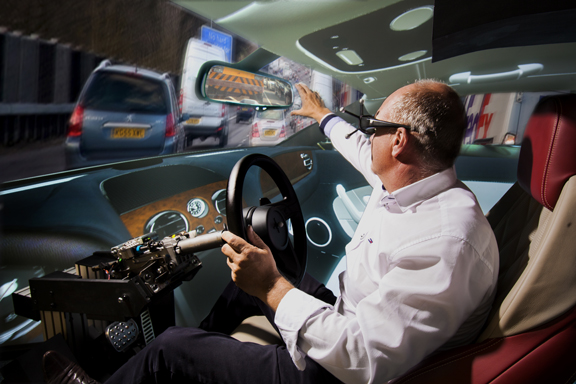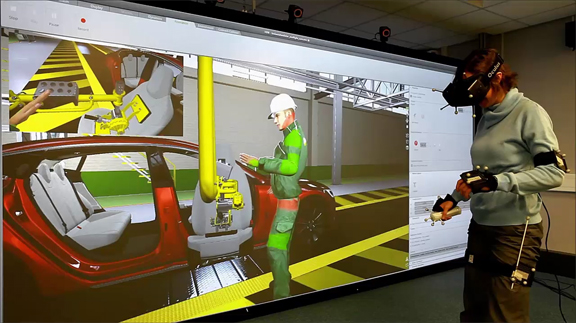
OPTIS VR lets Bentley Motors conduct ergonomic tests on virtual vehicle models (image courtesy of OPTIS).
April 25, 2017
The photo-like visuals you encounter in today’s virtual reality (VR) setups are so convincing it doesn’t take too much effort to believe you’re inside a spaceship, a battle-ravaged warship, or a pyramid, though you may only be sitting in a chair in a booth at a trade show. Yet, that illusion crumbles the moment you reach out to touch the supposed virtual objects around you. Since the panels, pillars, and decks constructed in pixels don’t feel like rusted metal, polished marble, and grainy sandstone they pretend to be, the lack of sensation brings you back to the realization that they’re merely visuals.
One company attempting to change that is OPTIS. It adds haptic feedback—a simulated sense of touch—to augment the VR experience. Engineers at Bentley Motors, who uses OPTIS’s technology to refine their design and manufacturing processes, were among the first to feel the effect, so to speak.
“Our collaboration with Bentley Motors came in two stages,” explains Chris Grieve, director of OPTIS West Coast Operations. “The first was driven by Bentley’s need to conduct ergonomic optimization in VR.”
 OPTIS VR lets Bentley Motors conduct ergonomic tests on virtual vehicle models (image courtesy of OPTIS).
OPTIS VR lets Bentley Motors conduct ergonomic tests on virtual vehicle models (image courtesy of OPTIS).Ergonomic Test
In the first setup built around 2012, the VR experience was delivered through a power wall, which gives the seated user an immersive view of the interior of the vehicle. The position of the seat in relation to the virtual world was configured to match precisely the driver’s location in a real vehicle. So the virtual setup allowed engineers to analyze the driver’s reaches and limits within the vehicle.
“For the ergonomic test, Benteley Motors wanted to use the power wall because it was supposed to be a collaborative design phase. They wanted people from different team to watch the experiment together and discuss it. Delivering that through a VR goggle would isolate the user from the rest of the team,” explains Grieve.
The VR ergonomic setup was powered by four NVIDIA Quadro 6000 GPUs, according to Grieve. The Quadro GPU line is meant for professional workstations certified for graphics-heavy CAD users. The Quadro 6000 GPUs are built on NVIDIA Fermi architecture, which supports high-performance computing (HPC). Therefore, OPTIS was able to use the collective processing power of four GPUs to drive the instantaneous visuals in the power wall.
Based on the success of the first VR setup, OPTIS was commissioned to design another VR setup, to simulate the car maker’s manufacturing process. Grieve explains, “That means, a setup that answers assembly and installation questions like, can I get the dashboard into the vehicle through the door? Or how do I bring the seat into the car? Or do I have a clear path to deliver the fuel tank to the vehicle? So it has to be much more immersive. For that, we used goggles and haptic devices.”
Adding Haptic Feedback
OPTIS’s virtual build process simulator for Bentley Motors delivers feedback in the form of vibration. In other words, when a user’s hand collides with virtual objects and barriers, he or she feels a vibration in the glove. This gives the car maker the option to load different vehicle models into the VR setup to figure out the best possible manufacturing and installation protocols.
The haptic feedback is made possible by NVIDIA PhysX, a game physics simulation technology from the GPU maker NVIDIA. “The collision calculation—the hand hitting the pipes, the vehicle walls, or the dashboard, for example—was all done on the GPU,” Grieve points out. The goggle and glove are more suitable to the manufacturing simulation because, “You want to be able to bend down, crawl, look around, and look up the way you would on a real manufacturing floor,” he adds.
“The technology today allows us to deliver very precise haptic feedback, if you want,” says Grieve. “We’ve made simulation systems for dental training, where you can feel the difference between collision with a tooth or the gum, for example. Haptic feedback is very useful for this type of process that involves very subtle movements.”
Importing scan data of existing vehicles and CATIA models of vehicles into the VR environment is straightforward, according to Grieve. “The main challenge was applying the right material data to scan data to create the accurate textures,” he says.
CAD files often have highly detailed material specifications, with each component clearly distinguishable from the others (for example, components made with aluminum, fiber, or leather). On the other hand, scan data consists of the entire object’s mesh geometry, but no manufacturing material data. It’s also much more difficult to separate the geometry into separate components (such as steering wheel, windshield, driver-side door, passenger-side door, and wheels).
 Haptic feedback in VR gives car makers a way to simulate and analyze where clashes and collisions might occur (image courtesy of OPTIS).
Haptic feedback in VR gives car makers a way to simulate and analyze where clashes and collisions might occur (image courtesy of OPTIS).Realistic Materials
OPTIS has a history stretching back to the 1990s, when it specialized in photometric and light propagation simulation. Grieve says, “We have laser devices that can accurately measure the materials BRDF.”
BRDF, or bidirectional reflectance distribution function, defines the way light interacts with opaque surfaces. In computer graphics, BRDF can be deployed to create virtual materials that mimic the behaviors of real-world materials, such as leather, plastic, and metal. “That’s why, with our technology, the textures inside the virtual vehicle are not just renderings but a physically correct representation of how you would see them when you’re sitting in a car,” says Grieve.
OPTIS’s proprietary technology stack includes HIM (the Realistic Human Experiment Analysis), THEIA-RT (a real time physics based renderer), SPEOS (The Optics, light & human vision simulation software), VRXperience (The Physics Simulator), and OMS2 hareware (The OPTIS Material scanner).
“Our technology accounts for the way people in different age ranges see objects,” Grieve explains. “For example, a younger person can read smaller text with less light than someone older. So, with our physically accurate simulation setup, we can tell you, for instance, a 25-year-old user can easily read this text but a 50-year-old user will be struggling to read it.”
OPTIS will present a session titled “Assembly Chain Training with Professional VR” at the upcoming NVIDIA GPU Technology Conference (May 8-11, Silicon Valley, California). For more, read the session details here.
For more on Bentley Motors’ VR setup, watch the video report below:
Subscribe to our FREE magazine, FREE email newsletters or both!
About the Author
Kenneth Wong is Digital Engineering’s resident blogger and senior editor. Email him at [email protected] or share your thoughts on this article at digitaleng.news/facebook.
Follow DE





